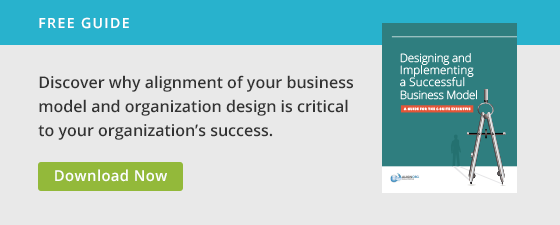You and your team have worked hard to create a business model and an organization design that meet your objectives, optimize your capabilities, address your customers’ needs, differentiate you in the marketplace, and account for any future complexities.
Good job! Your efforts will pay off. Your organization will be fiscally stronger and more distinctive as well as better prepared to serve your customers, compete in the marketplace, and foster a culture of loyalty and productivity.
BUT…
There’s always a “but,” isn’t there?
There’s absolutely no point in architecting and overseeing business model implementation and organization design if you’re not going to follow through.
What do we mean? Avoid the tendency to revert to old habits—negating all your efforts to bring about transformational change.
We witness complacency in organizations all the time. They don’t put in the maintenance, mechanisms, or funds necessary to sustain their business model implementation. Of course, some of that complacency is a side effect of company culture.
So, take a look at your culture. Is it counterproductive? If so, it could be impeding how well your business model and organization design are aligned.
The Follow-Up Effect
Surprisingly, many organizations go through considerable time and expense to create a business model and redesign their organization, but never fully implement it—let alone maintain it.
Can you imagine hiring and paying for an architect to create a blueprint of your dream home, and then casting aside its plans and construction? No one with any sense would do such a thing. Yet it happens in business transformations and redesigns all the time.
Avoid this by asking several questions.
Question #1: Does your business model help you get what you want (higher productivity, more customers, or something else)?
Business models are no longer linear—moving from product to market. We expect more from a business model. Be sure it is fulfilling your business objectives.
Question #2: How deeply are the leaders and employees engaged and supportive of the business model?
If your business leaders and employees are not fully invested in the business, your efforts could be for naught. Make sure current and future employees are fully supportive and understand why changes are necessary. If you can engender support, your rate of success will be exponential.
Question #3: Have you installed the business model and organization design that we architected and to what extent?
Conduct an assessment of your business model and organization design 9 to 12 months after alignment (though it could be as early as 6 months depending on the implementation scope). Look at processes, structures, people, rewards, etc. to see how effectively they are operating. This assessment can be done internally, or with the help of an outside firm.
Several areas should be examined:
- Capabilities—Is your organization capable of delivering? Are your people capable of delivering to the level you want?
- Objectives—Have you fulfilled all your objectives? For example, if increasing speed to market was an objective, is there evidence that you have done so?
- Initiatives—What initiatives were implemented (and to what level of success)? What initiatives still need to be implemented to get to your objectives?
A post-business model implementation assessment is often useful when conducted in conjunction with a minor business strategy and budget planning session.
For example, we assessed the progress of one AlignOrg Solutions’ client a year after they changed their organization design. We conducted interviews throughout the organization to see if they had implemented the changes and to what extent.
Our goal was to get a sense of how well people understood the organization design. We then sat down with the company’s leadership to evaluate the findings and develop a plan to address areas that weren’t working or where follow-through wasn’t happening.
Another important point—the language of your strategic plan must cascade down through the organization. Be clear about what you want to accomplish and how. Make sure all parties understand those objectives and the steps to get there—across and cascading down all levels.
Consider, as part of your annual strategic planning process, doing an organizational health assessment. During this process, your team should pinpoint areas where the organization is misaligned. Then identify the steps to realign them in the coming year.
When one client conducted this exercise, they found that the sales team was struggling. Frequently, when sales were down, the team requested additional sales people. Management would turn them down, usually because the sales department couldn’t provide adequate proof about why the staff increase was necessary.
After going through the strategic planning session, the sales team discovered that they needed to change the way the sales force was configured and articulate their need in a more convincing fashion to senior management. It proved to be very effective—with management ultimately agreeing to a staffing increase. As a result, the organization saw a notable increase in its sales.
We have a tendency to overestimate our abilities. After all, we’re human. We also hold on to a belief that it’s better to tackle many tasks in-house rather than paying an outsider to perform them. Sometimes it is better to recognize your limitations and bring in the resources you will need to make your business model implementation a genuine success.

